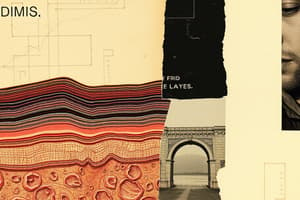Podcast
Questions and Answers
What is the main characteristic of the stratum corneum?
What is the main characteristic of the stratum corneum?
- Dead layer with flat cells (correct)
- Contains living cells
- Has Keratin synthesis
- Highly mitotically active
Which layer of the epidermis is primarily found in the palms and soles?
Which layer of the epidermis is primarily found in the palms and soles?
- Stratum spinosum
- Stratum lucidum (correct)
- Stratum granulosum
- Stratum basale
What do keratohyalin granules produce in the stratum granulosum?
What do keratohyalin granules produce in the stratum granulosum?
- Keratin
- Collagen
- Lipid molecules
- Filaggrin (correct)
Which structure helps in the attachment of keratinocytes in the stratum spinosum?
Which structure helps in the attachment of keratinocytes in the stratum spinosum?
How long does it typically take for keratinocytes to move from the stratum basale to shedding?
How long does it typically take for keratinocytes to move from the stratum basale to shedding?
What is the primary function of the stratum basale?
What is the primary function of the stratum basale?
What is the primary lipid source in the epidermis?
What is the primary lipid source in the epidermis?
In psoriasis, what is the epidermal turnover time?
In psoriasis, what is the epidermal turnover time?
Which layer is primarily responsible for the production of melanin?
Which layer is primarily responsible for the production of melanin?
What type of cells are found in the stratum spinosum?
What type of cells are found in the stratum spinosum?
Flashcards are hidden until you start studying
Study Notes
Structure of the Epidermis
- Composed of multiple layers, each with distinct functions and characteristics.
- Stratum Corneum: Outermost layer; consists of dead, flattened cells without nuclei, providing a protective barrier.
- Stratum Lucidum: Found primarily in thick skin areas like palms and soles; contains refractile granules of eleidin, contributing to skin's thickness.
- Stratum Granulosum: Contains keratohyalin granules that produce filaggrin; also houses lamellar granules (Odland bodies) that release lipids for skin hydration.
- Stratum Spinosum: Characterized by desmosomes, which join keratinocytes; this layer is where keratin synthesis occurs, adding strength to the skin.
- Stratum Basale (St. Germinativum): The deepest layer; highly proliferative, responsible for generating new keratinocytes through mitosis.
Dermal Components
- Dendritic Cells: Immune cells present within the epidermis that play a crucial role in skin defense.
- Melanocytes: Cells located in the stratum basale; responsible for producing melanin, which protects against UV radiation.
- Basement Membrane: Thin layer that supports the epidermis, facilitating the exchange of nutrients and waste between the epidermis and dermis.
Epidermal Turnover Time (ETT) / Skin Doubling Time
- ETT measures the duration for keratinocytes to migrate from the stratum basale to being shed from the skin surface.
- Average ETT is approximately 8 weeks (ranging from 42 to 75 days).
- In conditions like Psoriasis, epidermal turnover is significantly accelerated, occurring every 4 days.
Studying That Suits You
Use AI to generate personalized quizzes and flashcards to suit your learning preferences.




